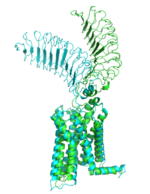Active and Inactive Form

Figure 1: Inactive form of the thyrotropin receptor shown in blue. Active form of the thyrotropin receptor shown in green.
The TSHR protein exists in two states, active and inactive. The sticks out from the cell membrane into the space outside the cell. The contains 7 alpha helices that reside within the cell membrane. The exists when bound to the thyroid stimulating hormone (TSH) (GREEN LINK). One proposed mechanism for the transition from the active to inactive describes that in its natural state, the TSHR ECD can spontaneously transition to the up state, leading to constitutive activity. In this active state, TSH will bind and keep the active state in the up position because of clash with the cell membrane.[1] Conformational change of ECD allows for signal transduction through the TM and into the cell. The ECD rotates 55 degrees up in the active form. REFERENCE FAUST
TSHR Agonists and Antagonists
The natural thyroid stimulating hormone binds the ECD and keeps the TSHR in the active state due to steric clash with the cell membrane. This steric clash comes from the ASN 52 (GREEN LINK) residue on the TSH (GREEN LINK).
M22
M22 is a [1]

Figure 2: Agonist and antagonist drugs for activating or inactivating the TSHR protein.


